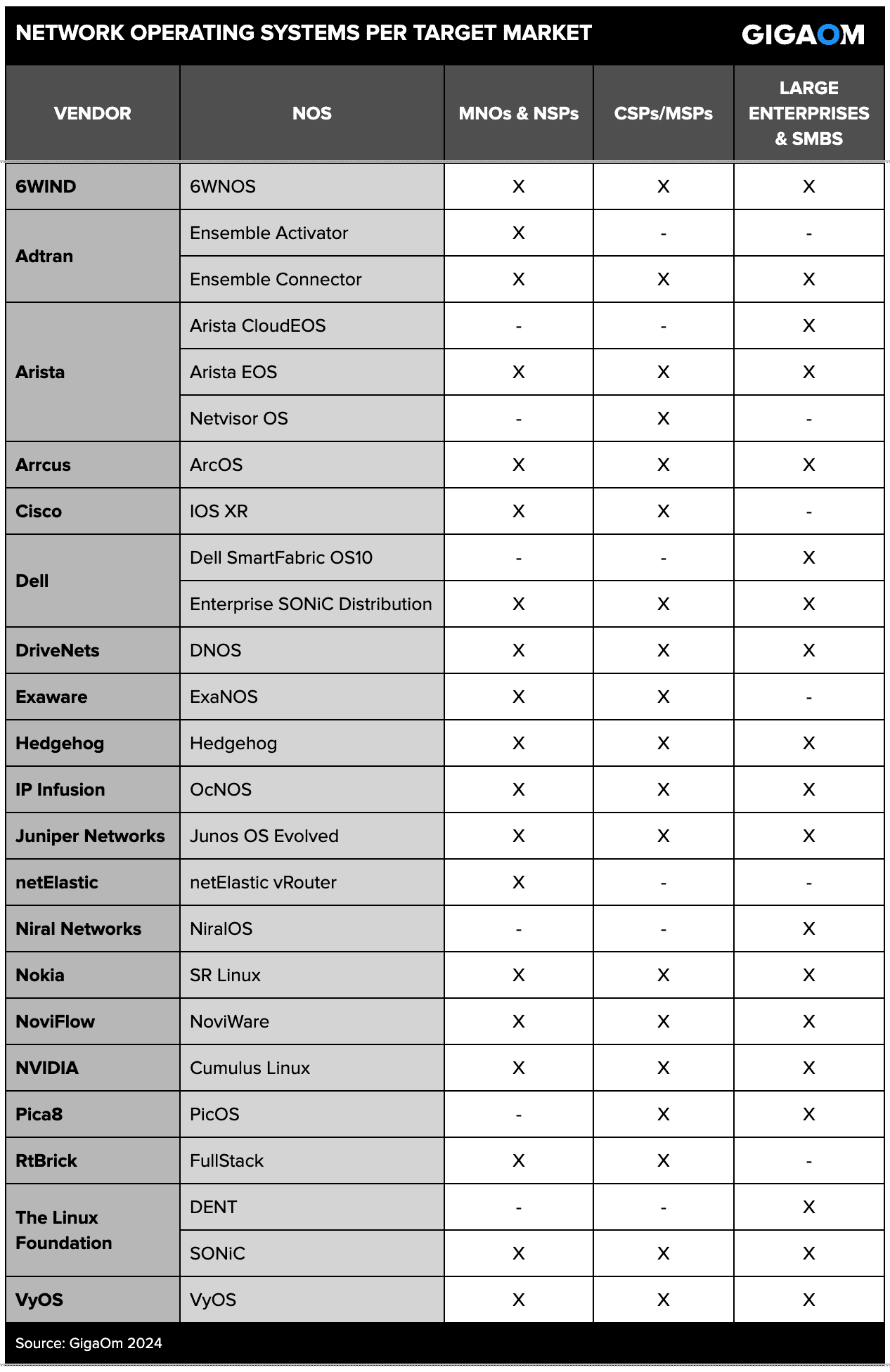Table of Contents
- Executive Summary
- Market Categories and Deployment Types
- Decision Criteria Comparison
- GigaOm Radar
- Solution Insights
- Analyst’s Outlook
- Methodology
- About Ivan McPhee
- About GigaOm
- Copyright
1. Executive Summary
The network operating system (NOS) landscape is evolving rapidly to address new demands, reflected by new acquisitions, new capabilities, new investors, new partnerships, and new customer engagements. Legacy vendors have adopted disaggregation to protect their installed base and mitigate supply chain issues; open source initiatives promise flexible, low-cost deployments with rapid community innovation; and new players have emerged with disruptive, cloud-native approaches, significant financial backing, and high-profile early adopters.
The result? A market defined by limited choice and “few sizes fit all” solutions has been replaced by disaggregated, cost-efficient, open-standards-based, interoperable tech stacks. Instead of purchasing and deploying a “best-fit” solution, customers can independently choose—and swap out—hardware and software based on what makes the most sense for each use case. In addition, disaggregation enables users to tailor their networks to the exact needs of their operations by adding or removing specific features, eliminating expensive forklift upgrades, and limiting vulnerabilities and risk exposure.
Moreover, the move toward disaggregated networks is reshaping the landscape for cloud and managed service providers (CSPs and MSPs) by offering them a way to build more flexible, scalable, and cost-effective network infrastructures. Disaggregation has opened the door to a broader ecosystem of hardware and software components with access to an open ecosystem, encouraging innovation and enabling service providers to create and deploy new services more rapidly. In addition, it allows service providers to better manage supply chain disruptions by not relying on a single vendor for hardware and software, leading to improved business agility.
NOSs for CSPs and MSPs are a critical component of the technology stack, significantly impacting the performance, security, and financial viability of the provider’s data center. While often overlooked due to the focus on cloud services, a NOS is a strategic choice for cloud and on-premises workloads, providing a way to migrate workloads effectively. In addition, it plays a significant role in managing the cloud data center’s resources, ensuring smooth and efficient operation of services and programs. The evolution and importance of these systems underscore the need for businesses to make strategic choices in their adoption and use.
As networking demands evolve, NOS vendors are innovating rapidly to deliver the tools needed for efficient network management. When selecting a NOS, CSPs and MSPs should look for a solution that facilitates efficient network management, enhances security, promotes collaboration, and supports business growth and evolution. In addition, they should consider the size of their enterprise, existing infrastructure, compatibility, technical expertise, budget, and networking requirements.
This is our fourth year evaluating the NOS space in the context of our Key Criteria and Radar reports. This report builds on our previous analysis and considers how the market has evolved over the last year.
GigaOm Radars for Network Operating Systems
Due to the large number of suppliers and solutions available, we have divided the NOS landscape into three reports based on the target market:
- Mobile network operators (MNOs) and network service providers (NSPs), often referred to as “telco service providers”
- Cloud and managed service providers (CSPs and MSPs)
- Large enterprises and small-to-medium businesses (SMBs)
Figure 1 indicates which vendors and NOSs are covered in each report. YoY changes relating to the vendors and solutions we evaluated are covered in section 4. “GigaOm Radar.”
Figure 1. Suppliers and NOSs included in each GigaOm Radar
This GigaOm Radar report evaluates 19 of the top NOSs and compares offerings against the capabilities (table stakes, key features, and emerging features) and nonfunctional requirements (business criteria) outlined in the companion Key Criteria report. Together, these reports provide an overview of the market, identify leading NOSs, and help decision-makers evaluate these solutions to make a more informed investment decision.
GIGAOM KEY CRITERIA AND RADAR REPORTS
The GigaOm Key Criteria report provides a detailed decision framework for IT and executive leadership assessing enterprise technologies. Each report defines relevant functional and nonfunctional aspects of solutions in a sector. The Key Criteria report informs the GigaOm Radar report, which provides a forward-looking assessment of vendor solutions in the sector.
